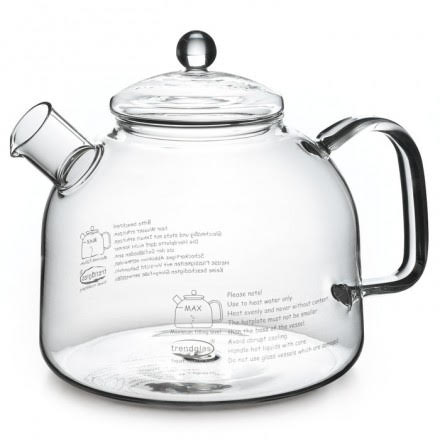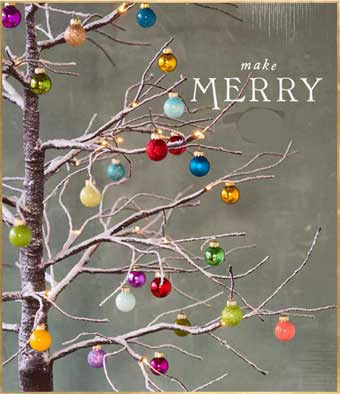
Submitted questions will be posted with my response by the following Tuesday or before.
Submitted comments will be moderated and approved within 24 hours.
Resources for Affordable Organic Fabrics & Upholstering Materials
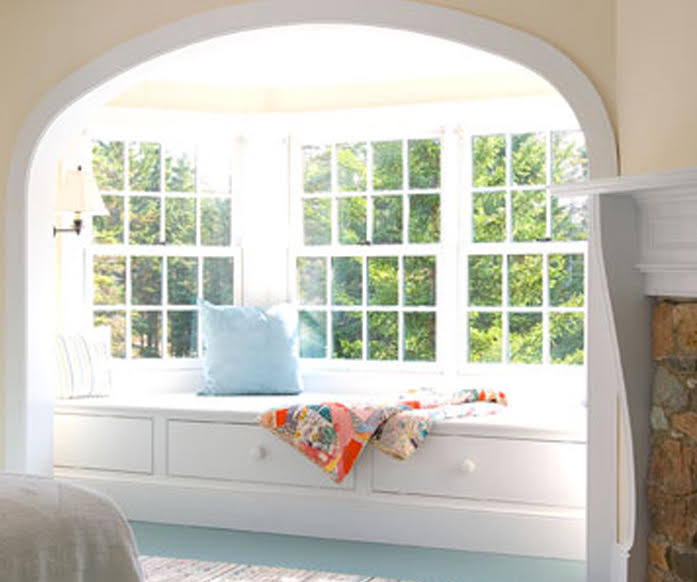
You can make a cushion for a charming window seat like this using ORGANIC upholstery materials.
Question from Sabrina
Hi Debra,
First of all, thanks for all of your wonderful information and advice over the last…Gosh, I don’t know how many years! Eight? You’ve helped me make better choices for my family and kids, specifically. I am deeply grateful.
I am going to make a cushion for a window seat for my avid reader kiddo, and I wanted to pass along some info I found about some great materials.
First: certified GOLS organic latex foam and organic cotton muslin from naturalupholstery.com. It’s the best price I found for organic latex foam.
I also am getting organic wool batting from foamorder.com, but they don’t sell organic latex, only “all natural”, whatever that means.
I will be covering the cushion in organic cotton canvas from fabricworm.com . They have the best selection at the best prices of organic fabric, that I have found.
Hope this is interesting and helpful.
Thanks again! And Happy New Year!
Debra’s Answer
Thanks for these great resources! I’m sure others will be interested in them too.
UV system in air conditioner OK for MCS?
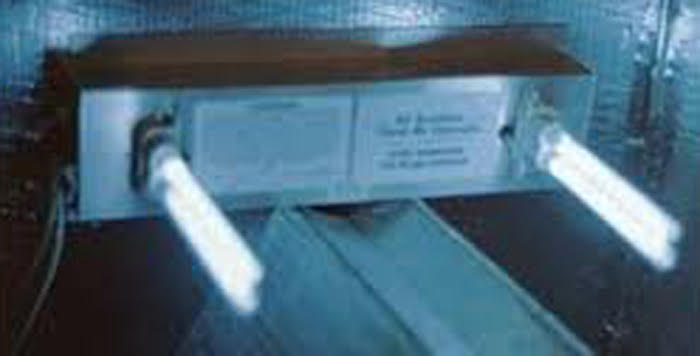
Hi Debra,
Anyone with mcs have a UV system for their air conditioner?
It is supposed to help prevent odors and mold, and my ac company is trying to persuade me to get it, but I know many years ago I read it is not good for an mcser.
A friend of mine had it and had to have it removed, but another mcser friend has one and is okay.
It is quite expensive and if I have to take it out, I will not get any of the money back. Thanks.
Debra’s Answer
UV lights produce varying amounts of ozone, but those intended for mold and germs produce very little. That may be what some very sensitive people are reacting to.
Readers, any experience with this?
EWG’s New Healthy Home Guides

Environmental Working Group has released a set of Healthy Home Guides. It’s the first time they have addressed exposure to chemicals in the home as a whole.
Rather than being comprehensive, these guides offer simple advice on avoiding less than a dozen chemicals of concern (lead, asbestos, flame retardants, VOCs, PFCs, antimicrobials, and radon).
Product-specific guides give only tips on what chemicals to avoid and what to look for, but no guidance on how to actually find these products.
Still, it’s a good educational effort to show there IS a problem with chemical exposures in the home and will make many more aware they should be looking for toxic-free products.
Co-workers with Fragrance
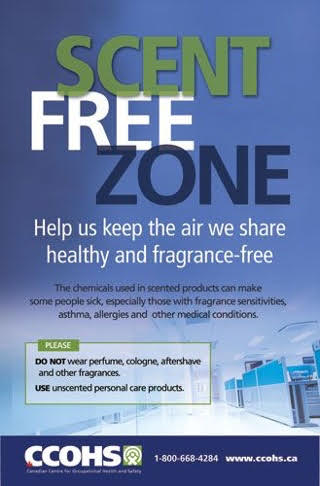 Question from Sus D
Question from Sus D
Hi Debra,
I work with people who have worked with me when I contracted fragrance allergies, they refuse to stop using their fragranced lotions and work in my office before I get there.
We have a policy addressing this but isn’t enforced even by HR department.
I work in a health care facility and it has gotten bad over the last five years. we have customers that have fragrance allergies also.
Why do the leaders let this happen with these employees who don’t seem to care about anyone but themselves. the leaders are aware, I know of one family that has wrote letters addressing the issue.
I was told I didn’t have the right to ask people to not use their product and the only manager that has tried to help feels like his hands are tied due to no one else caring to enforce the policy.
is their any organization to contact. already contacted JAN. Any advice. the manager wants to get me and the one that works in the office before me to met and have a discussion. I say it won’t help cuz she already knows and has know since the beginning but will not stop.
Debra’s Answer
Readers, anyone have a similar experience? Any advice?
Here is a page from The Chemical Sensitivity Foundation with many links regarding fragrance-free policies
I understand you have a policy and need help getting it enforced.
Here are some other resources that might help with enforcement. Some of them address refusal to comply. You might contact any of these organizations for help with your situation.
SAVVY WOMAN’S ALLIANCE: Five Friendly Fragrance-Free Signs
New ADA Guidelines for Fragrance Sensitivity Explained | Labor Law
Accommodation and Compliance Series: Employees with Fragrance ..
How I Found My New Refrigerator
 Larry and I have been living with his mom and two siblings for the past two months, and it had become abundantly clear that a standard refrigerator would not hold enough food for five adults with varying food preferences.
Larry and I have been living with his mom and two siblings for the past two months, and it had become abundantly clear that a standard refrigerator would not hold enough food for five adults with varying food preferences.
So we decided to get a small “apartment size” refrigerator to hold our food. A bit inconvenient to have to bring food into the kitchen from another room to prepare it, but the trade-off is that we can actually find our food and nobody else will eat it, intentionally or by accident.
And then we had to find one.
Larry looked on craigslist but didn’t find anything. I called around to used appliance stores, but they didn’t have any. Prices on new ones were more than $400, and I didn’t want a new refrigerator.
So Larry and I went to the bank to get some cash, and cleaned out his van so we could bring the refrigerator home, and looked again at craigslist.
There was a new listing.
It was about 45 minutes away, in Mill Valley. It was in perfect condition and totally clean. It was six months old so it didn’t have the “new refrigeratory smell” of plastic outgassing.
A young couple was selling it because they were moving out of their rental, which just happened to be a charming Arts & Crafts cottage in a grove of redwoods that was 100 years old. The owner wanted to tear down the house. The couple had moved everything out of the house and the refrigerator had to be gone today.
The ad said $200, but when Larry asked the seller how much he wanted, he said $150.
We took it.
Larry and I had wanted to spend $100 and his sister had given us $50 toward the refrigerator as an early Christmas present. So we spent the $100 we wanted to spend and got the exact refrigerator we wanted.
I have to tell you that intention plays a large part in finds like this. Knowing what we want and intending we will find it. Works every time.
Lead Paint on Glass Kettle
Question from Kaila
Hi Debra,
I recently purchased a glass kettle by Trendglas Jena to replace my old kettle and avoid leeching metals. Sadly, I didn’t see your comment on lead in the markings on the outside before I bought it, otherwise I would have purchased their smaller one with no markings.
I wrote the company and they sent me their test results (yes lead in the paint).
However, their kettles pass: FDA, Prop 65, REACH and several other European standards.
Is the risk with this paint just that it would wear over time and you’d come into contact with it washing, etc. Or that it can leach into the glass from the outside? I did not want to purchase a Chinese glass kettle and chose this because of the higher European safety standards. I may be able to exchange for one without markings. Thoughts?
Debra’s Answer
Europe does have higher safety standards.
I’m not really concerned about this.
A lot of research has been done on lead exposure and there are zero warnings about touching lead or breathing air next to a surface with lead paint. The hazard of lead exposure from paint is when it is ground into dust and inhaled, such as a door or window wearing away paint from opening and closing, and releasing it into the air. Also eating chips of lead paint is a hazard.
But I have no evidence or logic that would indicate to me that lead paint on a measuring cup would be a hazard.
Would I prefer there to be no lead paint on a product? Yes. But I don’t see a hazardous exposure here.
Someone please correct me if you have some evidence otherwise.
Organic and Pesticide-Free Christmas Trees, Wreath and Greenery

Every Christmas I look for organic Christmas trees, wreaths and greenery. In the past they have been difficult to find, but last year I have quite a few. Some of these are from Debra’s List, others I’m not adding only because they are seasonal. This is last year’s post updated.
Before you make a decision, check out this great article from Beyond Pesticides about Christmas Trees and Pesticides. They talk about pesticides used on Christmas trees, give suggestions on how to find organic trees in your area, and give lots of tips about how to handle and care for your tree.
And here’s another interesting article about how farmers are learning to reduce and eliminate their use of pesticides. It says that even though Christmas tree farmers do regularly use pesticides such as Roundup and Lorsban, the amount of pesticide residue that may be present on a Christmas tree by the time it gets to your house in “minor.” Most pesticides are sprayed in the spring or summer, so by December, they’ve been broken down by the elements.
ONLINE SOURCES
SILVERTON TREE FARM “Our Christmas trees are organically grown, with no pesticides used. Our tree farm is certified with the American Tree Farm system. To be certified we must follow “[t]he American Forest Foundation’s (AFF’s) 2010-2015 Standards of Sustainability for Forest Certification…” By following such standards we are promoting “…the vitality of renewable forest resources while protecting environmental, economic, and social benefits and work to increase public understanding of all benefits of sustainable forestry.” (http://www.treefarmsystem.org/) We are also working toward organic certification.”
LYNCH CREEK FARM Wreaths, garlands, centerpieces, and “trees” (assembled from sprigs) made from Noble fir boughs from the Cascade Mountains. Assembled on a farm that has been organic since 1980. “We generate revenue for local landowners, giving them a reason to protect their forest versus opting to clear-cut.”
GRANSTORM EVERGREEN Wreaths, garlands, and a cross wreath. “We do not use any pesticides when growing or making our evergreen products. We are a family business that has been making wreaths for over 30 years.”
OREGON HOLIDAY WREATHS Wreaths hand-made with fresh cut boughs of Noble Fir, Douglas Fir, Juniper, and Pine Cones. “We are 100% organic and pesticide-free.”
CREEKSIDE FARMS Holiday wreaths made from plants of the season that are not evergreens, grown naturally without pesticides.
ORGANIC BOUQUET Wreaths, plants, and fresh flowers. “All of our sustainably certified partner farms in Ecuador, Colombia and California use earth-friendly techniques to grow the flowers you enjoy! Instead of using harmful synthetic chemicals for fertilizers and pesticides, natural resources are used to grow these beautiful flowers.”
LOCAL SOURCES
GREEN PROMISE List of organic Christmas tree farms in USA. This list has been growing for many years and is updated for 2016.
SLOW FLOWERS A lovely online directory that lists local providers of “slow flowers”—flowers that are locally grown and often organic. Providers know the source of the flowers they sell.
CERTIFIED SUSTAINABLE CHRISTMAS TREES
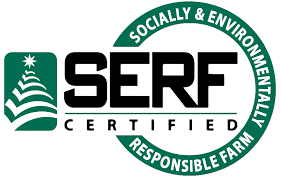 Now there is a program for Christmas tree farmers that educates and certifies farmers for sustainable practices in the Northwest. Socially and Environmentally Responsible Farm (SERF) Includes in their certification requirements use of Integrated Pest Management (IPM) instead of toxic pesticides.
Now there is a program for Christmas tree farmers that educates and certifies farmers for sustainable practices in the Northwest. Socially and Environmentally Responsible Farm (SERF) Includes in their certification requirements use of Integrated Pest Management (IPM) instead of toxic pesticides.
While only four farms in Oregon have been certified as of this writing, Oregon is the largest Christmas tree producer in the nation—more that 6 million tress are harvested there every year, and they are shipped all over the world. So you just might see a SERF seal at a Christmas tree lot near you.
A GIFT OF A WREATH
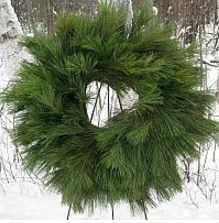 Last year I received a beautiful wreath from Jen’s Wreaths.
Last year I received a beautiful wreath from Jen’s Wreaths.
I had contacted them last week for this post, but there was a big blizzard in Minnesota and they didn’t get the message in time. When she finally responded, Jen offered to send me a wreath in exchange for adding them to the list. How could I refuse?
All the materials for their wreaths are hand-harvested from their local forests. “We are all about sustainable harvesting and a lot of our greenery actually comes from logging sites and the branches they discard…Some of our bows are made of synthetic material, but we’re on the look out for affordable, durable ribbon that is organic and healthy for everyone.” Maybe they will have that this year. Sustainably harvested wreaths with organic bows. 🙂
I emailed Jen on Friday I needed the wreath by Monday and it arrived on Saturday. It was full and lush and just beautiful. It was mixed greens—cedar, white pine, balsam fir and dogwood—so fragrant I could smell it even sitting in the next room as I wrote.
Nontoxic Choices for Artificial and Alternative Christmas Trees
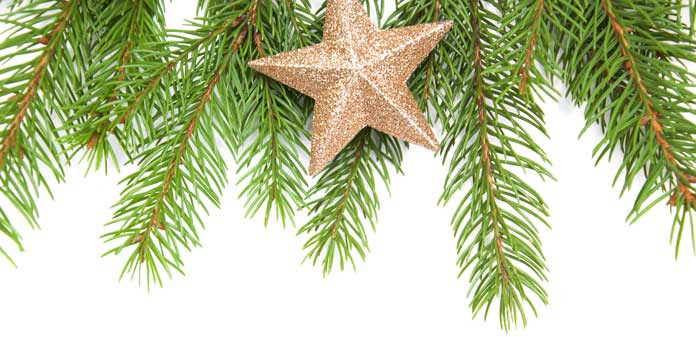
Question from Stacey
Hi Debra,
Just wondering if there are any new resources for artificial Christmas trees. We have gotten real trees in the past, but for various reasons, we prefer to get an artificial tree. However, I do not want a toxic tree. Any new recommendations?
Thanks so much!
Debra’s Answer
There are several types of artificial trees. I haven’t done an extensive study of all the types, but the plastic ones are most prevalent and most toxic.
PLASTIC TREES
Most plastic trees are made in China from polyvinyl chloride plastic (PVC). Since it is a semi-soft plastic, it would outgas phthalates, like a PVC shower curtain.How much it outgasses is hard to say. Cheap artificial trees are most likely 100% PVC.
I called Balsam Hill , who advertises having the most realistic and beautiful Christmas trees, and their trees are made in China. They have three grades of trees. Their “traditional” is 100% PVC, and their “realistic” and “most realistic” are 70% nontoxic polyethylene and 30% PVC.
If you want a plastic artificial tree, your best choice is the Christmas trees sold at IKEA.
It turns out the Fejka trees at IKEA are made from polyethylene and polypropylene, two of the least toxic plastics available. Polyethylene is so nontoxic it is approved by GOTS to be safe enough to use to make a crib mattress. There are no other chemicals on these trees like fire retardants. I called IKEA and they said no. I asked them if, in general, ALL the materials are included on the tag and online and they said yes. So if it’s not on the tag, it’s not in the product. These trees are not sold online, only at local IKEA stores. But call first if you want one, as they are not available in all stores.

So if you want a plastic tree, be sure to check what type of plastic it’s made from. Avoid PVC, choose polyethylene.
OTHER OPTIONS FOR ALTERNATIVES
Here is a solid hardwood trees made in New Hampshire by Festive Trees. I don’t know anything about the paint or finish, but they will last year after year. You may be able to get one unfinished and paint it yourself, or if you are handy or know someone who is, you could even make one in any size you want.
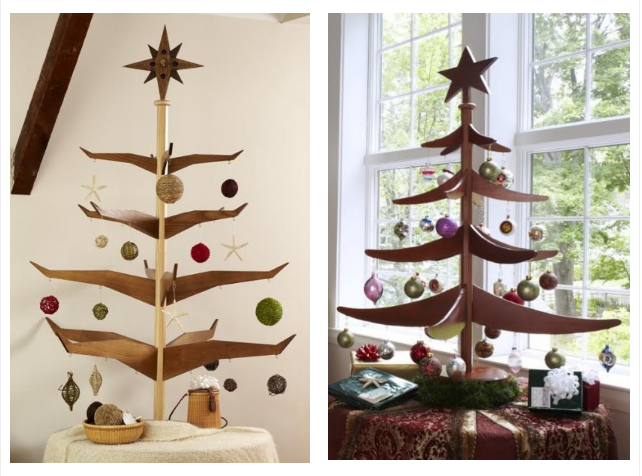
Ii you don’t want to buy a tree, consider finding or purchasing bare branches on which to hang lights and ornaments. Though the evergreen is the traditional greenery for winter as it symbolizes life continuing even in the dark days, bare branches can be beautiful and reflect the bare trees outdoors. Right now where I am living there is a beautiful persimmon tree with bare branches and bright orange permissions hanging all over it like Christmas tree ornaments.
One Christmas I was living in a rented room in someone else’s house and didn’t have room for a tree. But just before Christmas there was a big winter storm, and when I went for a walk the street was strewn with evergreen branches. So I gathered as many as I could carry and put them in a vase, and that was my tree.
Or trim whatever evergreens you have in your yard, put the trimmings in a vase, and decorate them.
There are all kinds of creative ways to come up with a Christmas tree by using various nontoxic materials and your imagination. You could easily make this tree below out of branches. For more inspiration on ways to make your own Christmas tree, see 25 Creative Christmas Tree Ideas.
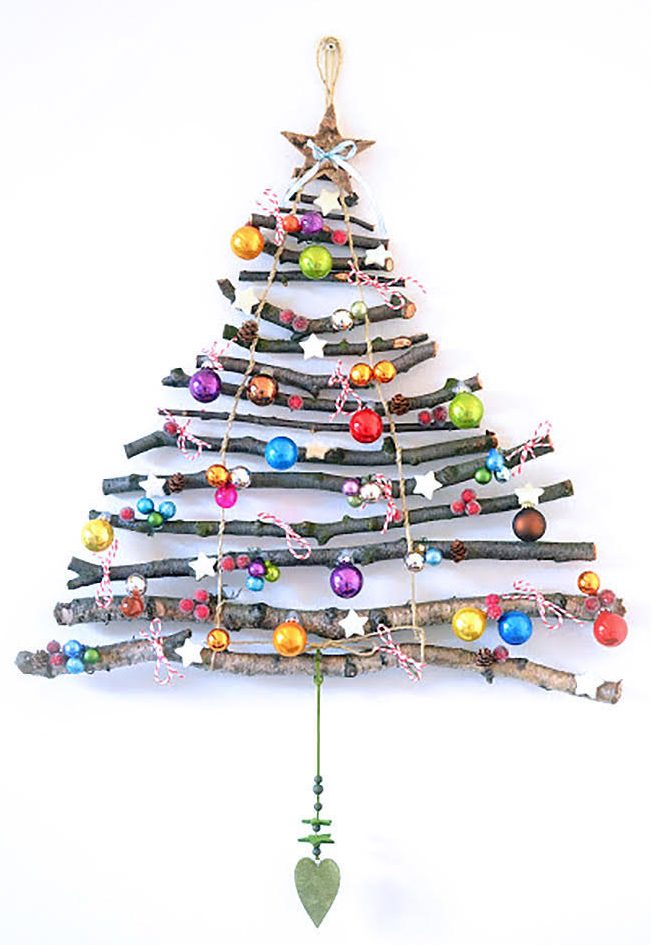
Fresh Cut Trees
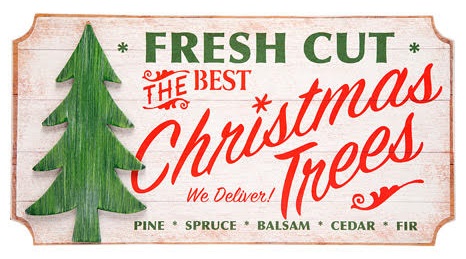
Fresh-cut trees are sold almost everywhere at holiday time – from seasonal tree lots to supermarkets.
Rural areas near urban centers often have tree farms where you can cut your own tree – a fun outing to take during the holidays that will connect you and your family with the tree in it’s natural environment and the family who grew it. Purchasing from a local tree farm supports your local economy and allows you to choose a species of tree that flourishes in your local bioregion. You can also meet the growers and talk to them about their growing methods.
To forego a holiday tree for the sake of preserving our natural forests is not necessary. Until fairly recently, all Christmas trees came from the forest, but this is no longer true. Of the approximately 35 million Christmas trees that are sold each year, 95 percent are shipped or sold directly from Christmas tree farms.
The environmental effect of fresh-cut holiday trees is actually beneficial. Over one million acres of land have been planted in Christmas trees, and over 100,000 people are employed growing them, mostly on family farms. Though some of these trees are harvested each year, their value as a commercial crop adds this acreage to the total amount of forested land on the Earth. For every fresh-cut tree harvested, three seedlings are planted in its place and about ten others are still being grown on farms to prepare for the next ten harvest seasons.
One organic grower reports that in addition to generating income, Christmas trees are a pleasure to grow. In her organic tree plantation, several species of birds have taken up residence in their trees and in the grasses that grow between the trees. The soil in the abandoned field in which she is growing her trees is improving every year, as it is being maintained as an agricultural area. The plantation provides a place of scenic beauty, a place for picnics in spring, summer and fall, and a place for wildlife. Because they sell on a cut-your-own basis, the growers see many of their friends and neighbors when they come for trees.
SAFE SPECIES FOR FRESH CUT TREES
Certain kinds of Christmas trees contain natural substances that can be harmful even to those in good health.
Six species account for about 90 percent of the holiday tree trade. Scotch pine is most popular, with about 40 percent of the market, followed by Douglas fir which accounts for about 35 percent. The other common species are noble fir, white pine, balsam fir and white spruce. Different species predominate in different parts of the country.
Of these species, the varieties of pine are the most problematic. Pine contains resins and other aromatic chemicals that have natural insecticidal and bactericidal properties that can kill insects and the bacteria that cause odor.
In this case, however, “natural” does not mean safe. These same chemicals can also damage the respiratory tract, causing chronic respiratory disease, and asthma. So if anyone in your family has increased asthma in the wintertime, it could be your Christmas tree.
The safer choice would be a natural fir or spruce tree, as they do not contain these irritating chemicals. While it was easy to find literature on the dangers of pine, I was able to find nothing on the health effects of exposure to fir or spruce. I live in a fir forest and the Miwok Indians who used to live here would drink tea made from the fir needles. So I think a fir tree would be safe.
Many years ago I asked Mia Rose, who had a long-time dedication to safe ingredients, about the health effects of spruce and fir. She made a natural holiday air freshener that contains essential oils of these trees. “I could not find any data that showed any negative effects of fir or spruce,” she said. “In fact, they have a positive effect of relieving stress and elevating emotions.”
HOW TO KEEP YOUR FRESH-CUT TREE FRESH
When you bring your tree home, remove any needles lodged among the branches, then care for it as you would cut flowers.
Keep the tree outdoors in a protected area until you are ready to decorate it. Keep the cut end of the trunk submerged in water. Saw a fresh straight cut across the trunk about an inch up from the original cut to open the tree stem for water intake. Then place it in any large container filled with fresh water. If you allow the water level to drop below the fresh cut, a seal will form, just as it does on cut flowers, and a new cut will be necessary. Use hot water the first time to dissolve pitch that may be clogging water conduction tissues.
Use a Christmas tree holder that holds water. If you refill the water on a regular basis, your tree will remain fresh and fire-resistant throughout the season and will not lose its needles.
FRESH TREES DON’T CATCH FIRE
There is some concern that fresh Christmas trees will start fires. A fresh Christmas tree that is well cared for will not catch fire. In fact, I read that there have been reports of house fires where the house burned completely, but the fresh Christmas tree in the house did not even catch fire.
However, it is wise to unplug the tree lights before retiring or leaving home. While the tree is unlikely to burn, overheated lights can start a fire among the paper gift wrapping or curtains.
It is also best not to place your tree next to the fireplace. Again, while a well cared for tree is unlikely to burn, sparks from the fire could ignite the paper wrapping of gifts placed beneath them.
RECYCLE YOUR TREE INTO A BIRD FEEDER
Evergreen trees can be “recycled” in the garden as a to make a protected bird habitat, adding color and interest to the winter garden. The branches provide shelter from strong winds and cold. Attract birds with fruit slices, seed cakes, suet bags, and pine cones smeared with peanut butter and seeds, hung on the trees like ornaments. Make strings of popcorn or cranberries, or strings alternating cranberries with half-inch cubes of beef suet, or apples wedges with raisins and Cheerios. You can hang any leftover Christmas cookies on the tree, too.
Place your tree near a window so you can observe the action. To deter unwanted visitors such as raccoons and squirrels, try mounting your feeder on a pole at least fifteen feet from any overhead branches and at least fifteen feet off the ground. Mount an inverted metal cone just below the feeder.
When spring comes and the tree begins to dry out, it can easily be broken apart or chopped to make mulch and returned to the garden.
Living Trees
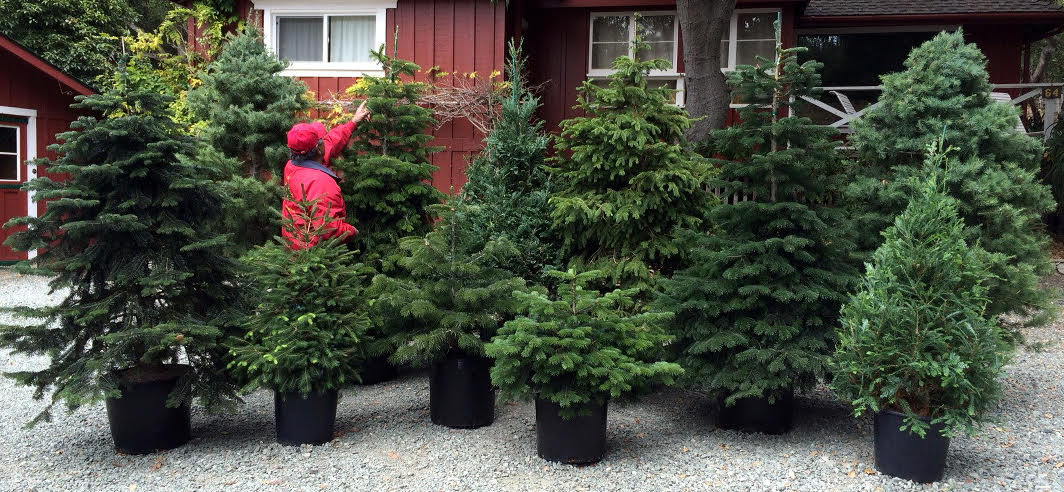
Instead of cutting a tree for the holidays, you can plant one, when you choose a living tree. Sold in containers, living trees have their roots intact and can be planted outdoors or grown in their containers following the holiday.
PLANTING YOUR TREE OUTDOORS
The most important decision to make when choosing a living tree is where it will be planted after the holiday season.
Choose the spot to plant your tree before you buy, making sure that there is plenty of room for the tree to grow.
If you don’t have space on your property to plant a tree, find out about tree-planting programs in your community who would welcome a post-holiday donation. If you decide to make a gift of your tree, be sure to check with the recipient regarding preferred species.
If you have a large yard that needs planting, you can plant a “holiday tree grove”. Each year purchase a tree and add it to the grove. This will become a special place to enjoy year-round, and a reminder of past celebrations.
Once planted, outdoor evergreens can be decorated and serve as a holiday tree for the neighborhood.
CONTAINER TREES
If you have limited space, you can plant a living tree in a container and bring it indoors each season. The remainder of the year it can add background greenery to a deck or patio.
You can keep your tree a manageable size with yearly pruning. Our recycled Worldwise EcoPlanter is especially suited for this purpose as it will not break, chip, or crack in cold weather and will last as long as the tree.
Nurturing a tree throughout the year gives it a special meaning during the holidays. Because you participate in its growth and care throughout the whole year, it becomes part of your family, a “friend” who comes to celebrate with you year after year. You could start with a tree seedling and watch it grow, particularly if you start it on a child’s first holiday or a first holiday of a marriage.
CHOOSING THE RIGHT SPECIES
The most important aspects of choosing the right species are to choose a species that will thrive in your area, and how fast the tree will grow. If you are planting outdoors, you probably want a tree that will quickly grow to full size. If you are going to keep it in a container, it is best to choose a species that is naturally slow-growing.
These are the most popular species for living holiday trees:
| Common name | Scientific name | Nursery sizes | Best climates |
| Slow growth | |||
| WHITE FIR | A. concolor | 1-6 feet | Everywhere |
| COLORADO BLUE SPRUCE | P. pungens ‘Glauca’ | 1-6 feet | Everywhere |
| NORWAY SPRUCE | Picea abies | 3-7 feet | Everywhere except south and deserts |
| DWARF ALBERTA SPRUCE | P. glauca ‘conica’ | 1-4 feet | Everywhere except deserts |
| NOBLE FIR | Abies procera | 3-6 feet | NE, W, Midwest, Rockies |
| Average growth | |||
| JAPANESE BLACK PINE | P. thubergiana | 1-6 feet | Everywhere |
| NORFOLK ISLAND PINE | Araucaria heterophylla | 1-7 feet |
Tropical, Subtropical, SW, S, Gulf Coast
|
| SCOTCH PINE | Pinus sylvestris | 2-8 feet | NW, W, Midwest, Rockies |
| DOUGLAS FIR | Pseudotsuga menziesii | 3-7 feet | NW, W, Midwest, Rockies |
| Fast growth | |||
| ALEPPO PINE | P. halepensis | 2-6 feet | S, SW, deserts |
| MONTEREY PINE | P. radiata | 2-8 feet | N, Midwest, E, W |
| MONDELL PINE | P. eldarica | 1-8 feet | SW |
CARING FOR YOUR TREE INDOORS
Since warm indoor air is not the native winter habitat for evergreen trees, it is important to properly care for your tree to keep it green and healthy through the holidays.
Limit indoor time to two weeks, and place it on the opposite side of the room from any heat sources, including fireplaces and woodstoves, heater vents, and unshaded south-facing windows.
Use “cool” 5-watt lights on the tree, as heat from regular lights can dry out the tree.
Give the tree a good soaking before bringing it indoors. Let it drain for a day or two to prevent ending up with a puddle on the floor. Make sure to put the pot in a saucer and the saucer on a Worldwise SurfaceSaver to protect the floor. Water every three days to keep the soil moist.
For time-release watering, and to keep the tree cool, try watering with ice cubes. As they melt, the tree roots will slowly absorb the water.

